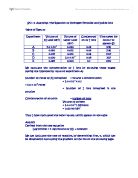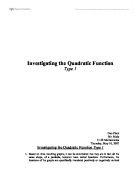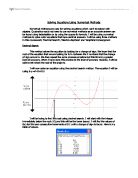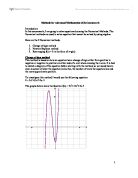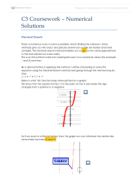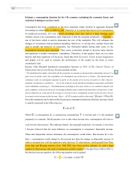Numerical integration coursework
Numerical integration coursework Problem For this coursework, I am going to use my knowledge of numerical methods to produce an approximation to an area which does not have an analytic solution. I will be finding the approximation, to an appropriate degree of accuracy, of the integral shown above. On the graph below is the area that I will be approximating underneath the curve of y= from x=0 to x=2. Note that throughout my method I worked in radians. This problem is appropriate for numerical solution as I chose my graph to be a polynomial curve involving a square root so that there would be no analytical solution. Due to the fact that I cannot yet integrate functions like this approximating methods will have to be used. According to the numerical methods module the three approximation methods to be used are: Mid-point rule- this method was adopted because it is used to approximate the area underneath the graph by dividing it up into individual rectangles. Trapezium rule- this method was adopted because it is used to approximate the area underneath the graph, this is done so by dividing it up into individual trapeziums. Simpson’s rule- I have realised that out of the two, the mid-point rule and the trapezium rule, the mid-point rule is more accurate, Simpson’s rule is therefore just an average that uses this fact by weighting the average towards the mid-point rule to
Analysing; The Reaction of Hydrogen Peroxide and Iodide ions
Skill 3: Analysing; The Reaction of Hydrogen Peroxide and Iodide ions Table of Results Experiment Volume of KI used (dm3) Volume of water used (dm3) Concentration of I- ions Time taken for colour to appear (S) A 5.0 x 10-3 0.020 0.02 9:56 B 0.010 0.015 0.04 5:36 C 0.015 0.010 0.06 4:07 D 0.020 5.0 x 10-3 0.08 3:27 E 0.025 0.000 0.1 2:40 We calculate the concentration of I- ions by following these stages (taking the hypothetical value of experiment A) Number of moles of KI contained = volume x concentration = 5.0 x 10-3 x 0.1 = 5.0 x 10-4 moles = Number of I- ions contained in the solution Concentration of solution = number of mols Volume of solvent = 5.0 x 10-4 / (25/1000) = 0.02 mol/dm3 Thus I have calculated the other values, which appear on the table Analysis Derived from the rate equation Log (1/time) = n log (volume of KI) + constant We can calculate the rate of reaction, by determining first, n, which can be obtained by calculating the gradient of the line on the following page. Nevertheless, we would need to convert most of the data into logs, Experiment Log Volume of KI (dm3) Time taken in seconds Log (1/time) A -2.30 596 -2.77 B -2.00 336 -2.53 C -1.82 247 -2.39 D -1.70 207 -2.31 E -1.60 60 -2.20 Thus, we could derive the gradient of the graph, by drawing it, as seen upon the nest page. We
Investigating the Quadratic Function.
Investigating the Quadratic Function Type 1 Dan Plant Mr. Maly 1 IB Mathematics Thursday, May 10, 2007 Investigating the Quadratic Function Type 1 . Based on three resulting graphs, it can be determined that they are in fact all the same shape, of a parabola, however have varied locations. Furthermore, the locations of the graphs are specifically translated positively or negatively vertical according to the constant added or subtracted to the variable (x2). These three graphs may be generalized by the following statement; adding a positive or negative constant h will shift the graph vertically h units in the function y = (x2)+h. (Refer to attached graphs) 2. Based on the three resulting graphs, it can be determined that they are in fact all the same shape, of a parabola, however they have varied locations. Furthermore, the locations of the graphs are specifically translated positively or negatively horizontal according to the constant added or subtracted directly to the variable x. These three graphs may be generalized by the following statement; replacing x in a function x2 with the expression (x - h), where h is positive or negative the graph will be translated to left or right respectively h units. (Refer to attached graphs) 3. The vertex of the equation y = x2 is (0,0). Therefore, the vertex of y = (x - 4)2 + 5 is (4,5) based on previous conclusions above. Using
Observation of people obeying temporary signs.
Psychology Coursework - Observation of people obeying temporary signs. Introduction: Milgram's work showed that when people are put in a situation where they have to obey orders given by an authority figure, they will do so, even if the task goes against their ethical beliefs. I wanted to observe the obedience of pupils when reading an order on a sign when written by either an authority figure or another pupil. Research aim: To find out if people will obey temporary signs on a drink vending machine in a Sixth Form common room, written by an authority figure and a school pupil. Hypothesis: Pupils will obey the sign written by an authority figure and disobey the sign when written a school pupil. Null Hypothesis: There will be no difference in obedience between the signs written by the authority figure and school pupil Variables: The independent variable was whom the signs were written by. The dependent variable was whether the pupil obeyed the signs or not. Population: Sixth Form pupils (16 and over), in UK. Sample: An opportunity sample of 40 Sixth Form pupils from a secondary school in Letchworth per lunch hour. They included male and female subjects, ranging from 16 to 18 years old. Method: Over the period of one lunch hour, it was observed how many Sixth Form pupils purchased drinks from the one drink vending machine in the Sixth Form common room. This was
Investigate the relationships between the lengths of the 3 sides of the right angled triangles and the perimeters and areas of these triangles.
Aim: To investigate the relationships between the lengths of the 3 sides of the right angled triangles and the perimeters and areas of these triangles. Task 1: a) The numbers 5, 12, 13 satisfy the condition. 5² + 12² = 13² Because 5² = 5x5 = 25 12² = 12x12 = 144 13² = 13x13 = 169 And so 5² + 12² = 25 + 144 = 169 = 132 b) The Numbers 7, 24, 25 also satisfy the condition. 7² + 24² =25² Because 7² = 7x7 = 49 24² = 24x24 = 576 25² = 25x25 = 525 And so 7² + 24² = 49+ 576 = 625 = 25² Task2: The perimeter and area of the triangle are: a) b) Length of shortest side Length of middle side Length of longest side Perimeter Area 3 4 5 2 6 5 2 3 30 30 7 24 25 84 84 Task3: Length of short side is going to be in fixed steps meaning that this is a linear sequence and the length of middle side and longest side is actually a quadratic sequence because they are not in fixed steps and in geometric sequence. 4 , 12 , 24 , 40 8 , 12 , 16 4 , 4 5 , 13 , 25 , 41 8 , 12 , 16 4 , 4 Length of shortest side: Term no 2 3 4 5 Sequence 3 5 7 9 1 Sequence 2n 4 6 8 0 Sequence 2n + 1 Length of the middle side: F (n) = an² + bn +c F= (1) = a x 1² + b x 1 + c = a + b + c = 4 - eqn1 F= (2) = a x 2² + b x 2 + c = 4a + 2b + c = 12 - eqn2 F= (3) = a
Solving Equations by numerical methods.
Solving Equations by numerical methods. The fact that the vast majority of the numbers on the real number line are irrational (i.e. cannot be put in the form p/q, where p and q are integers) has an associated consequence that the vast majority of equations involving powers of x (i.e. polynomials) are insoluble by closed analytical techniques. This coursework's solution implies finding values of x say c1, c2-...c3 where f(c1)=0; f(c2)=0 and so on. Further transcendental equations and non- linear equations require numerical methods for their solution. It is to be noted that in no way are numerical methods inferior to analytical solutions, they are indeed the only practical solutions available, however on the down side no exact solution is possible and error bounds have to be placed on the solution given. In this coursework three main methods of solution from one-dimensional equations are given, each of the methods could be extended to the multi-dimensional case. The aim of this coursework is to show example of the methods in action, where these are successful and where they are not. A comparison between the methods will also be attempted. Method 1: Decimal Search SOLVING AN EQUATION WITH THIS METHOD Fig1. Shows the function f(x) = 12 ln(x) - x3/2. (Where ln(x) represents the natural logarithm of x.) To find the roots, the equation is: 2 ln(x) - x3/2 = 0 This equation
Solving Equations Using Numerical Methods
Solving Equations Using Numerical Methods Numerical methods are used for solving equations which can't be solved with algebra. Quadratics would not need to use numerical methods as an accurate answer can be found using factorisation or by using the quadratic formula. I will be using numerical methods to solve cubic equations that have decimal answers. I will be using three methods in this coursework; 'Decimal Search', 'Newton-Raphson' and 'Graphical Convergence'. Decimal Search This method solves the equation by looking for a change of sign. We know that the root of the equation that we are looking for is in between the 2 numbers that the change of sign occurs in. We then repeat the same process as before but this time to a greater level of accuracy. When I have done this process to the level of accuracy required, I will be able to tell where the root of the angle is. I will now solve an equation using the decimal search method. The equation I will be using is y=x³-2x+0.5 I will be trying to find this root using decimal search. I will start with the integer immediately below the root (-2) and this will be the lower bound. I will find the values of f(x) for this and consecutive increments of 0.1 until a change of sign is found. Here is my table of values. From this table, I can see that the change in sign appears in between -1.6 and -1.5. To be certain that the root is
Examining, analysing and comparing three different ways in which to find the roots to an equation.
Advanced Mathematics (C3) Coursework Introduction: For my investigation, I will be examining, analysing and comparing three different ways in which to find the roots to an equation. It will include the "Change of Sign Method", the "Newton-Raphson Method" and finally the method of rearranging "f(x) = 0" into the form "x = g(x)". I will be finding roots of equations using the methods, and hence compare the merits and flaws of the methods with each other. I will analyse which is the best in terms of factors such as a speed of convergence and ease of use with available software and hardware. Change of Sign Method: This method finds a root to an equation by looking at when values of f(x) change sign from positive to negative or vice versa. This works because when the value of f(x) changes its sign, it must have passed through the x axis, and thus the root is somewhere between the two values that changed. The technique of the method can be done in many ways such as by interval bisection or linear interpolation. However, I will be using the decimal search method. With decimal search, you first draw the graph of the curve that is to be investigated, and look for where the curve passes through the x axis, as these points are where the roots are. But as you cannot guess exactly where the roots are, you take intervals: the two points surrounding where the curve passes through the
Methods for Advanced Mathematic
Methods for Advanced Mathematics (C3) Coursework Introduction: In this coursework, I am going to solve equations by using the Numerical Methods. The Numerical methods are used to solve equation that cannot be solved by using algebra. Here are the 3 Numerical methods: . Change of sign method 2. Newton-Raphson method 3. Rearranging f(x) = 0 in the form of x=g(x) Change of sign method This method is based on how an equation has a change of sign either from positive to negative or negative to positive on either side of a root when crossing the x-axis. It is best to sketch a diagram of the equation before starting with the method, so we would have a clear structure of what the equation looks like, the number of roots the equation has and the roots approximate position. To investigate this method I would use the following equation 0 = 3x3+11x2+2x-5 The graphs below show the function f(x) = 3x3+11x2+2x-5 x f(x) 6 051 5 655 4 371 3 81 2 67 1 0 -5 -1 -2 1 -3 7 -4 -29 -5 -115 -6 -269 x (1dp) f(x) -1 -0.9 -0.077 As we can see from the results table, there is a change of sign between [-1, -0.9]. This indicates the root is in the interval. To make sure the result is as accurate as possible, I will repeat the process until a sufficient number of decimal places are achieved. I will calculate this to 3 decimal places. A zoomed in of the root
By the software Equation Grapher, we can find the smallest positive root of y=0 and then factorize the equation to find the other roots.
.(a) By the software Equation Grapher, we can find the smallest positive root of y=0 and then factorize the equation to find the other roots. (i) From the graph, we can see that the smallest positive root is 1 f (1) = 13 - 12 - 4(1) + 4 = 0 By the Remainder Theorem, 1 is a root and (x-1) is a factor of y = x3- x 2- 4x + 4 f (x) = x3- x 2- 4x + 4 = (x-1) (x2-4) = (x-1) (x-2) (x+2) Therefore, by the Factor Theorem, the equation y = x3- x 2- 4x + 4 has roots at x = -2, 1 and 2. Hence, the smallest positive root is 1 or (ii) From the graph, it seems that the smallest positive root is f () = 2() 3 - () 2 - 8() + 4 = 0 By the Remainder Theorem, is root and (2x-1) is a factor of y = 2x3-x 2-8x+4 f(x) = 2x3-x 2-8x+4 = (2x-1) (x2-4) = (2x-1) (x-2) (x+2) Therefore, by the Factor Theorem, the equation y = 2x3-x 2-8x+4 has roots at x = -2, and 2. Hence, the smallest positive root is . (iii) From the graph, it seems that the smallest positive root is f () = 3() 3 - () 2 - 12() + 4 = 0 By the Remainder Theorem, is a root and (3x-1) is a factor of y = 3x3-x 2-12x+4 f (x) = 3x3-x 2-12x+4 = (3x-1) (x2-4) = (3x-1) (x-2) (x+2) Therefore, by the Factor Theorem, the equation y = 3x3-x 2-12x+4 has roots at x = -2, and 2. Hence, the smallest positive root is . (iv) From the graph, it seems that the smallest positive root is f () = 4() 3 - () 2 - 16() +



